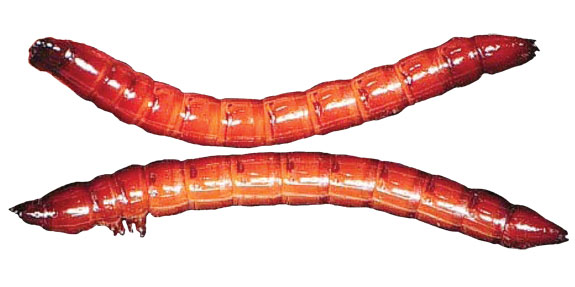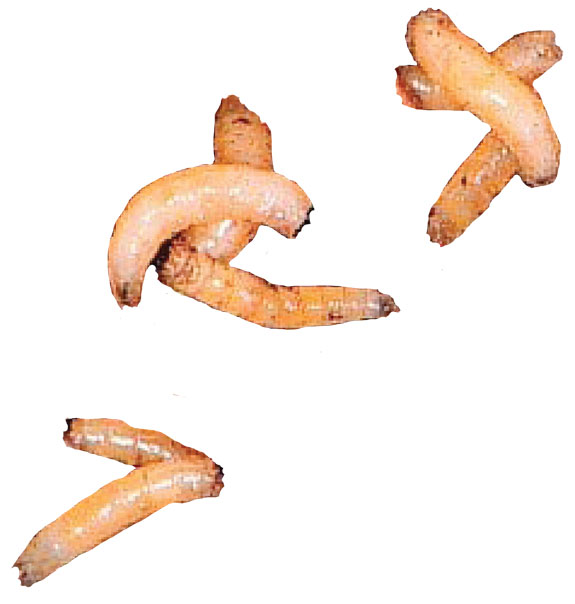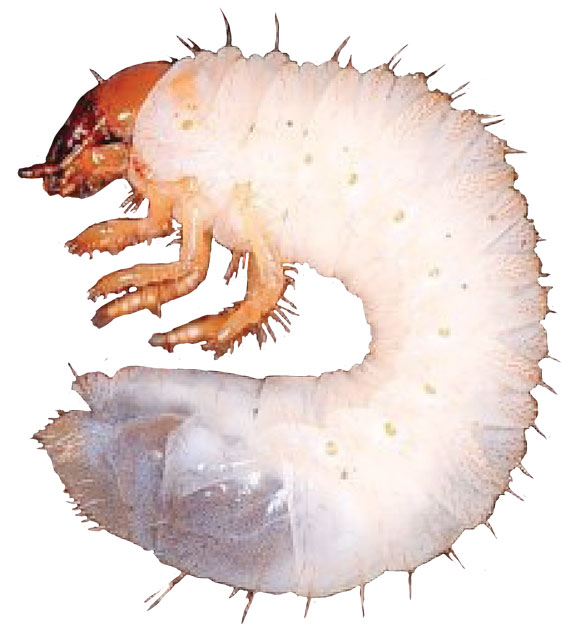
Wireworms
Wireworms are the most commonly encountered secondary soil insects in North America. Larvae live in the soil for several years, feeding on seeds, seedlings and roots or dead organic matter.
• Identification
Wireworms are cylindrical, wire-like larvae that range from about 0.5 to 1.5 inches in length. Their bodies typically are hard, slick and shiny, varying from yellow to copper or brown in color.
Three pairs of small, thin legs can be seen behind the head, and the last body segment may be rounded, forked or notched.
• Injury to corn
Wireworm larvae damage corn in a number of ways with their chewing mouth parts. Wireworms are attracted to seeds by the carbon dioxide given off during germination.
They bore into seeds, feeding on the germ and leaving a hollowed-out kernel. They also tunnel into the base of seedling plants below ground, often damaging the growing point and killing the plant.
In larger plants, wireworms feed on roots and may tunnel up into the plant several inches above ground.
Wireworm damage to a cornfield appears as missing plants and stunted seedlings that wilt and die as drier soil conditions develop.
If the growing point is injured, the plant will appear dead in the center and stunted, often accompanied by excessive tillering. Most damage is inflicted in the spring, when wireworms are near the soil surface and plants are small.
Wireworm infestations are usually spotty, with only some field areas affected. Wireworms cannot tolerate dry soils and often are found concentrated in poorly drained areas.
This may be a result of abundant weeds in these areas as well as soil moisture.
Because wireworms live for several years in the soil, damage to the current crop may be related to a crop grown in the field two or more years previously.
Adult wireworms prefer to lay eggs in grassy fields or small-grain stubble, so wireworm infestations are more pronounced following small grains or long-standing areas such as pasture, forage crops, CRP or a persistent grassy-weed problem in a field.
• Life cycle and biology
Adult beetles live 10 to 12 months, spending most of their time in the soil.
Females lay their eggs mainly around the roots of grasses, and the egg stage lasts a few days to a few weeks. In stark contrast to the egg stage, the larval stage lasts from two to six years, depending on the climate and wireworm species.
All stages and nearly all sizes of larvae may be found in the soil at one time.
Eventually, wireworms pupate in cells in the ground during the summer or fall of their final larval year. Adults emerge the following spring.
• Movement in soil
Wireworms migrate up and down in the soil profile in response to changes in temperature and moisture. Small vertical tunnels or soil cracks allow this movement.
Wireworms move up near the soil surface when soil temperatures reach 55ºF and move down again if temperatures exceed 75ºF. At 90ºF and above, wireworms desiccate and die.
As soils become dry and hot as summer progresses, wireworms descend in the soil and are difficult to find, even in heavily infested fields.

Seedcorn maggots
Seedcorn maggots are the larval stage of a fly and are found in all arable regions of North America. The maggots feed on decaying organic matter and the germinating seeds of many plants, including corn.
• Identification
The seedcorn maggot is a creamy-white larva tapered at the front end, but with no legs or visible head. At about 0.25 inches long, it is smaller than common housefly larvae but similar in appearance.
• Injury to corn
Seedcorn maggots damage corn by feeding inside the kernel, resulting in failed germination or emergence of a weakened seedling.
Any condition that delays germination results in more exposure of the seed to attack. Cold, wet soils are therefore more likely to result in injury. Fields with decaying organic matter near the soil surface are at risk of infestation.
• Life cycle and biology
The seedcorn maggot overwinters as a brown pupa in the soil. When soil temperatures increase in the spring, the adult fly emerges.
The adult is attracted to fields with decaying organic matter for egg-laying. Eggs are deposited near seeds and larvae feed upon germinating seeds after hatching. Larvae also may feed on decaying organic matter.
The entire life cycle of seedcorn maggots is completed in about three weeks, so several generations occur every year. However, only the first generation is considered economically damaging to corn.
This is because the timing of the first generation usually coincides with seed germination under cooler, wetter soil conditions.

White grubs
Two kinds of white grubs feed on corn roots – the true white grub, which has a three-year life cycle, and the annual white grub, which completes its life cycle in one year.
True white grubs are the larvae of June beetles (also called May beetles) and are more damaging to corn than the annual grubs.
Annual white grubs are the larvae of the Japanese beetle, masked chafers (several species) or European chafer. Both are native to North America and found throughout most corn-growing regions.
• Identification
All white grubs have a brown head capsule, a white, C-shaped body, three pairs of legs, a slightly enlarged abdomen and a dark posterior. They are generally 0.75 to 1.5 inches in length when straightened out.
True white grubs can be distinguished from masked chafer grubs by observing the raster (the underside of the last abdominal segment).
True white grubs and European chafers have two parallel rows of stiff hairs on the raster, in addition to scattered hairs. Japanese beetle grubs have a V-shaped raster. Masked chafer grubs have scattered hairs only on the raster.
• Annual white grubs
Annual white grubs hatch in the summer and begin to feed on plant roots and dead organic matter. Corn plants usually have sufficient root mass at this time to tolerate annual white grub feeding with no economic loss.
These grubs overwinter deep in the soil and move back to the soil surface in the spring. They feed a little in the spring but generally are not considered a threat to corn.
• Injury to corn by true white grubs
True white grubs do not feed on seeds, but can damage corn by feeding on seedling corn roots. Light infestations usually do not cause economic losses, as corn can tolerate moderate root pruning and adjust to minimal stand loss.
However, high infestations can result in significant stand loss, especially during extended cool periods when small corn plants are unable to outgrow feeding damage.
Damage usually is confined to localized pockets within a field, and replanting those areas sometimes may be required. However, damage usually is not severe enough to warrant replanting the entire field.
Corn plants injured severely by true white grub root feeding turn yellow, wilt and die. Injured plants also may turn purple if unable to take up phosphorous due to root pruning.
Damage may be increased under drought stress conditions, because water and nutrient uptake is hindered in damaged plants. Infestations are patchy within a field due to differences in soil characteristics and proximity to major sources of food for adults.
• Life cycle and biology of true white grubs
True white grubs require three years to complete a single generation. Generations overlap, however, so there are adults and larvae present every year.
First-stage larvae hatch in the summer of the first year. They feed on organic matter, then move below the frost line to overwinter in the soil.
Second-stage larvae migrate upward and feed on plant roots during the spring of the second year. Damage usually is greatest in the second year of the life cycle.
Larvae again descend in the soil to overwinter and ascend in the spring of the third year to feed on roots. While stands can be affected, damage usually is not as great as in the second year.
Larvae pupate in midsummer and pupae transform to adults in late summer. Adults do not emerge from the soil until the following spring.
Management of secondary soil insects
Management of secondary soil insects is challenging. Variable distribution of insects within the field complicates scouting, and not all insects have clearly established scouting and treating guidelines.
Damage by secondary insects also depends on weather conditions during germination and early seedling growth.
In the past, management options were limited largely to planting-time soil insecticides, but today, seed-applied insecticides offer growers a practical, effective and safe alternative.
Soil insecticides
Furrow-applied, T-banded or banded soil insecticides can help protect the seed and seedling zone from insect damage.
However, scouting soil insects prior to planting is difficult due to their spotty distribution in fields, their movement up and down in the soil profile, the labor-intensive nature of the scouting and other demands on growers at this time of the season.
Seed-applied insecticides
Insecticide seed treatment options help improve plant stands and crop performance by protecting germinating seeds from damage and stand loss caused by wireworms and seedcorn maggots.
Labels also indicate reduced feeding by white grubs during emergence and seedling stages. With some seed treatments, the active ingredients offer contact activity to protect the corn seed but also move systemically throughout the seedling plant.
Treating based on field and crop history
Growers often must make treatment decisions based on field or crop history, including:• no-till or conservation tillage, especially those fields with high levels of previous crop residue
• previous infestation of soil insects in field or field areas
• previous crop of sod or other soil insect host
• areas with dense weed growth, especially grassy weeds
• history of manure application or a green manure crop
• presence of other organic matter on the soil surface
These criteria will lead the grower to an effective management decision in many cases. FG
—Excerpts from Pioneer Hi-Bred International newsletter Crop Insights, Vol. 20, No. 3







